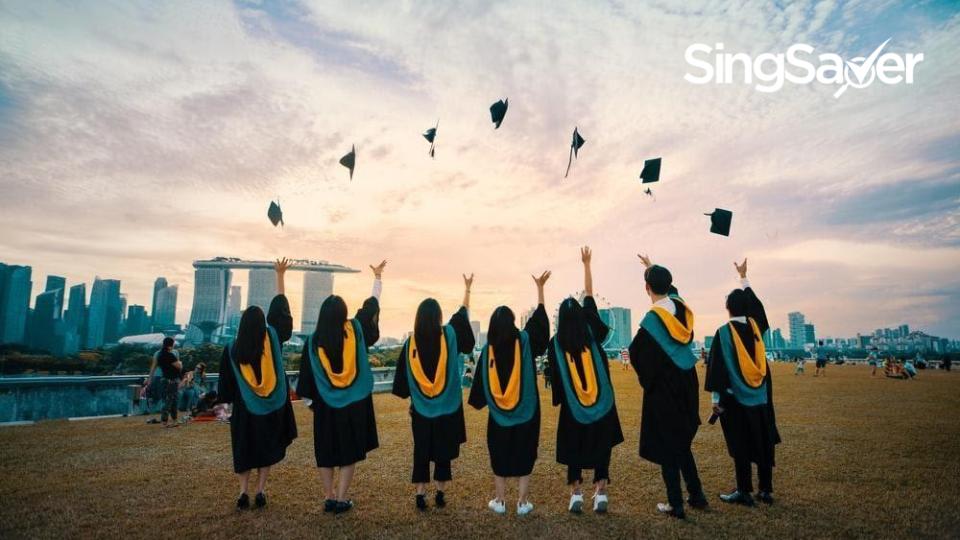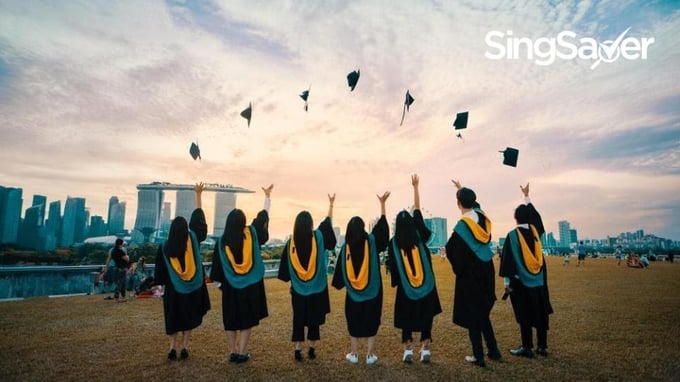
Planning your finances for your next child? Make sure to include the cost of educating them in your budget.
As the saying goes, give a man a fish and you will feed him for a day. Teach a man to fish and you will feed him for a lifetime.
For many societies (including Singapore), education is the tool we equip our next generation with so that they can survive in society.
But education comes at a price, and you want to make sure you are financially prepared to provide your child with the education they need to succeed.
In this guide, we will dissect the cost of education in Singapore for Singaporeans, permanent residents (PRs) and international students.
Table of contents
- Primary school fees
- Secondary school fees
- Post-secondary: Junior College fees
- Post-secondary: Institute of Technical Education fees
- Post-secondary: Polytechnic fees
- Tertiary fees
- Subsidy, tuition grants and education loans
- Estimated cost of education for one child
School fees for every stage in your child’s education
Primary school
Since all Singaporeans are required to finish primary education unless an exemption is granted, primary education is considered the educational foundation for most Singaporeans. Thus, the fees for primary school, including miscellaneous ones, are almost negligible.
| Citizenship | School Fees (Monthly) |
| Singapore Citizen | Free |
| PR | S$205 |
| International (Asean) | S$465 |
| International | S$775 |
Other Fees
- Miscellaneous fees: S$6.50 (monthly)
Secondary school
For secondary education, there are different types of schools that your child might be enrolled in, depending on their Primary School Leaving Exam (PSLE) score.
Based on MOE’s definition, there are five types of schools in Singapore’s secondary education.
| School Type | Description |
| Government school | Government-run schools with standardised fees. |
| Government-aided school | Government-aided schools set up by various community organisations. |
| Independent school | Schools that set their own fees and develop their own programmes. They might/might not follow the national syllabus. |
| Specialised independent school | Specialised education catering to students with talent/strong interest in the following areas: Mathematics and Science, Arts, Sports, and Applied Learning. NUS High School of Mathematics and Science School of Science and Technology Singapore Sports School School of the Arts |
| Special education school (SPED) | Schools for those with autism spectrum disorder: AWWA School 2Eden School 1, 2 Metta School 2 St. Andrew's New Autism School Pathlight School 1, 2, 3 St. Andrew's Autism School Rainbow Centre School 3 Schools for those with mild intellectual disability: Chaoyang School Delta Senior School Grace Orchard School Katong School Metta School Tanglin School Schools for those with moderate to severe intellectual disability: Fernvale Gardens School Lee Kong Chian Gardens School Towner Gardens School Woodlands Gardens School Schools for those with multiple disabilities: AWWA School 1 Cerebral Palsy Alliance Singapore School (CPASS) Rainbow Centre Margaret Drive School Rainbow Centre Yishun Park School Schools for those with sensory impairment: Canossian School (Hearing loss) Lighthouse School (Hearing loss, visual impairment) |
- Some schools within these four categories are also Special Assistance Plan (SAP) schools, which are committed to nurturing bilingual and bicultural students immersed in Chinese language and culture.
- Some schools within these four categories have an autonomous status. This means that they follow the national syllabus, but offer a wider range of enrichment programmes that develop your child’s talents.
| Citizenship | School Fees (Monthly) | ||||
| Government School (including SAP) | Government-Aided School (including SAP) | Independent School | Specialised Independent School | Special Education School | |
| Singapore Citizen | S$25 to S$43 | S$25 to S$43 | S$300 to S$600 | S$300 to S$830 | S$14 to S$250, depending on the level of development |
| PR | S$400 to S$418 | S$400 to S$418 | S$600 to S$1,000 | S$450 to S$800 | S$14 to S$350, depending on the level of development |
| International (Asean) | S$800 to S$818 | S$800 to S$818 | S$1,000 to S$2,500 | S$950 to S$2,700 | - |
| International | S$1,470 to S$1,488 | S$1,470 to S$1,488 |
Other Fees
- Miscellaneous fees: S$10 (monthly)
Post-secondary: Junior College
Once students finish their O’Levels, there are three different education routes that they can pursue. The most common one is Junior College (JC), which used to be called Pre-U.
In JC, students will undergo a curriculum very much like that in secondary school. The focus of JC is to prepare students for their A’Levels and subsequently their tertiary education. Thus, the fee structure is very similar to secondary school.
| Citizenship | School Fees (Monthly) |
| Singapore Citizen | S$6 |
| PR | S$460 |
| International (Asean) | S$1,040 |
| International | S$1,800 |
Other Fees
- Miscellaneous fees: S$13.50 (monthly)
Post-secondary: Institute of Technical Education
For students who are not academically inclined, they can choose to go the Institute of Technical Education (ITE) route. ITE imparts practical and hands-on skills to students so that they can enjoy better job prospects and career progression once they graduate.
For Higher NITEC students who perform exceptionally well, they can choose to further their studies at a Polytechnic.
| Citizenship | Higher NITEC School Fees (Annual) | NITEC School Fees (Annual) |
| Singapore Citizen | S$626 | S$446 |
| PR | S$7,844 | S$5,634 |
| International | S$20,482 | S$15,572 |
Post-secondary: Polytechnic
Once students finish their O’Levels, they have the option of studying in a polytechnic as well. Unlike in JC, students in polytechnics are given more autonomy on what they want to study and how they want to plan their education journey, which is much more fluid and involves less micromanagement from the lecturers.
As polytechnics prepare students with hands-on skills for the workforce, they are suitable for students who are already clear on what they want to pursue post-graduation.
| Citizenship | Tuition Fees (Annual) | ||||
| Singapore Poly | Temasek Poly | Ngee Ann Poly | Nanyang Poly | Republic Poly | |
| Singapore Citizen | S$2,900 | S$2987.50 | S$2,900 | S$2,971.30 | S$2,986.50 |
| PR | S$6,000 | S$3,117.50 | S$6,000 | S$6,101.30 | S$6,116.50 |
| International | S$11,000 | S$5,650.70 | S$11,000 | S$10,934.50 | S$11,159.50 |
Tertiary
Tertiary education is the final stage of one’s education journey. In Singapore, there are currently six public universities that are eligible for MOE tuition fee grant:
- National University of Singapore (NUS)
- Nanyang Technological University (NTU)
- Singapore Management University (SMU)
- Singapore University of Technology and Design (SUTD)
- Singapore University of Social Sciences (SUSS)
Singapore Institute of Technology (SIT)
| Citizenship | Tuition Fees (Annual) | |||||
| NUS | NTU | SMU | SUTD | SUSS (for 4 years) | SIT (for 4 years) | |
| Singapore Citizen | S$8,200 to S$28,900 | S$8,200 to S$34,700 | S$11,400 to S$12,650 | S$13,200 | S$30,000 to S$33,440 | S$22,500 to S$43,280 |
| PR | S$11,500 to S$41,700 | S$11,500 to S$49,000 | S$16,000 to S$17,700 | S$18,600 | S$62,880 to S$66,880 | S$47,160 to S$84,000 |
| International (with Tuition Grant) | S$17,550 to S$63,750 | S$17,550 to S$74,900 | S$24,500 to S$27,050 | S$28,450 | S$75,200 to S$80,000 | S$63,558 to S$113,248.80 |
| International (without Tuition Grant) | S$29,850 to S$159,600 | S$31,970 to S$36,830 | S$44,770 to S$47,320 | S$60,615.50 | S$125,760 to S$133,760 | S$96,878 to S$158,189 |
Government subsidies for your child’s education (Singaporeans)
To ensure that every Singaporean has an equal opportunity to education regardless of family background, the government continues to provide financial support to Singaporean families. This is especially targeted at low- to middle-income families.
Edusave top-up
Besides school fee subsidies, the government tops up the Edusave account for primary (S$230) and secondary school (S$290) children yearly. This adds up to a total of S$2,540 by the time your child finishes his/her secondary education.
ComCare Student Care Fee Assistance Scheme
To support lower income families, the government also provides subsidies on monthly student care fees, as well as a one-time grant for enrolment fees. This is administered under the ComCare Student Care Fee Assistance scheme.
| Family size ≤ 4 | Family size ≥ 5 | Student Care Centre with fees below S$295 | Student Care Centres with fees above S$295 |
| Gross Household Income (S$) | Gross Per Capita Income (S$) | Subsidy (%) | Maximum subsidy (S$) |
| ≤ 1,500 | ≤ 375 | 98 | 290 |
| 1501 - 2,000 | 376 - 500 | 95 | 280 |
| 2,001 - 2,200 | 501 - 550 | 90 | 266 |
| 2,201 - 2,400 | 551 - 600 | 85 | 251 |
| 2,401 - 2,600 | 601 - 650 | 80 | 236 |
| 2,601 - 2,800 | 651 - 700 | 70 | 207 |
| 2,801 - 3,000 | 701 - 750 | 60 | 177 |
| 3,001 - 3,200 | 751 - 800 | 50 | 148 |
| 3,201 - 3,400 | 801 - 850 | 40 | 118 |
| 3,401 - 3,500 | 851 - 875 | 40 | 118 |
| 3,501 - 4,000 | 876 - 1,000 | 30 | 89 |
| 4,001 - 4,500 | 1,001 - 1,125 | 20 | 59 |
Source: Ministry of Social and Family Development
Bursary
For tertiary education like polytechnics and universities, there are also bursaries made available for children from lower income families. This is to ensure that those who worked hard and secured their spot in an MOE-subsidised polytechnic or university course would be given the chance to pursue higher education.
| Bursary For Polytechnic | Eligibility Criteria | Annual Bursary Amount | |
| Gross Household Income | Per Capita Income | ||
| Higher Education Community Bursary | ≤ S$2,750 | ≤ S$690 | S$2,750 |
| S$2,751 to S$4,000 | S$691 to S$1,000 | S$2,400 | |
| Higher Education Bursary | S$4,000 to S$6,900 | S$1,001 to S$1,725 | S$1,900 |
| S$6,901 to S$9,000 | S$1,726 to S$2,250 | S$850 |
| Bursary For University | Eligibility Criteria | Annual Bursary Amount | |
| Gross Household Income | Per Capita Income | ||
| Higher Education Community Bursary | ≤ S$2,750 | ≤ S$690 | S$6,200 |
| S$2,751 to S$4,000 | S$691 to S$1,000 | S$5,000 | |
| Higher Education Bursary | S$4,000 to S$6,900 | S$1,001 to S$1,725 | S$3,200 |
| S$6,901 to S$9,000 | S$1,726 to S$2,250 | S$1,350 |
| Bursary For University (Dentistry, Medicine) | Eligibility Criteria | Annual Bursary Amount | |
| Gross Household Income | Per Capita Income | ||
| Higher Education Community Bursary | ≤ S$2,750 | ≤ S$690 | S$18,900 (NUS)S$24,700 (NTU) |
| S$2,751 to S$4,000 | S$691 to S$1,000 | S$14,900 (NUS)S$20,700 (NTU) | |
| Higher Education Bursary | S$4,000 to S$6,900 | S$1,001 to S$1,725 | S$10,900 (NUS)S$16,700 (NTU) |
| S$6,901 to S$9,000 | $1,726 to SS$2,250 | S$4,900 (NUS)S$10,700 (NTU) |
Source: Ministry of Education
Estimated cost of education for one child
Overall, the cost of education for a child in Singapore from primary to tertiary will set you back at least:
- S$35,416 for the JC route: S$468 (primary) + S$1,920 (secondary) + S$468 (JC) + S$32,800 (university)
- S$43,648 for the polytechnic route: S$468 (primary) + S$1,920 (secondary) + S$8,700 (poly) + S$32,800 (university)
And this is with government education subsidies in place.
If your child enrols in independent schools or pursue tertiary courses that are more expensive, the fees will be even higher.
Furthermore, there are other costs involved such as enrichment courses, material fees, as well as overseas trips that schools might organise to provide more exposure for your child.
Thus, it is important for parents to save up as much as possible to secure their child’s future and equip them with the skills to fish for themselves.
Here are some useful investing articles that can help you save for your child’s education.
There are many ways you can finance your child’s education without putting too much financial burden on yourself. One way is to get an education loan to support your child’s tertiary education.
Find the best education loan within minutes using our comparison tool.
Read these next:
This Is How Much You Can Borrow From Different Loans In Singapore
Citibank Quick Cash Loan Review (2021): Enjoy 0% Interest Rate For 12-Month Loans
Best Personal Loans In Singapore With The Lowest Interest Rates (2021)
Personal Loans Comparison: SCB CashOne vs Citi Quick Cash vs HSBC Personal Loan
What’s An Insurance Policy Loan, And When Should You Cash In On It?
Similar articles
The Real Cost: How Much Does Higher Education Really Cost in Singapore?
Best Tuition Centres In Singapore
MBA Programmes in Singapore (2022) – Guide To Fees, List of Universities, Part-Time MBA
Complete Guide to Tuition Grants in Singapore for Diploma & Undergraduate Courses 2021
Tuition Centres Vs Private Tutors: Which Is More Cost-Effective?
Edusave And PSEA Guide For Parents In Singapore
Bus, MRT fares to cost 4 to 20 cents more per trip from Dec 28
What’s The Difference Between Tuition Fee Loan And Study Loan?










